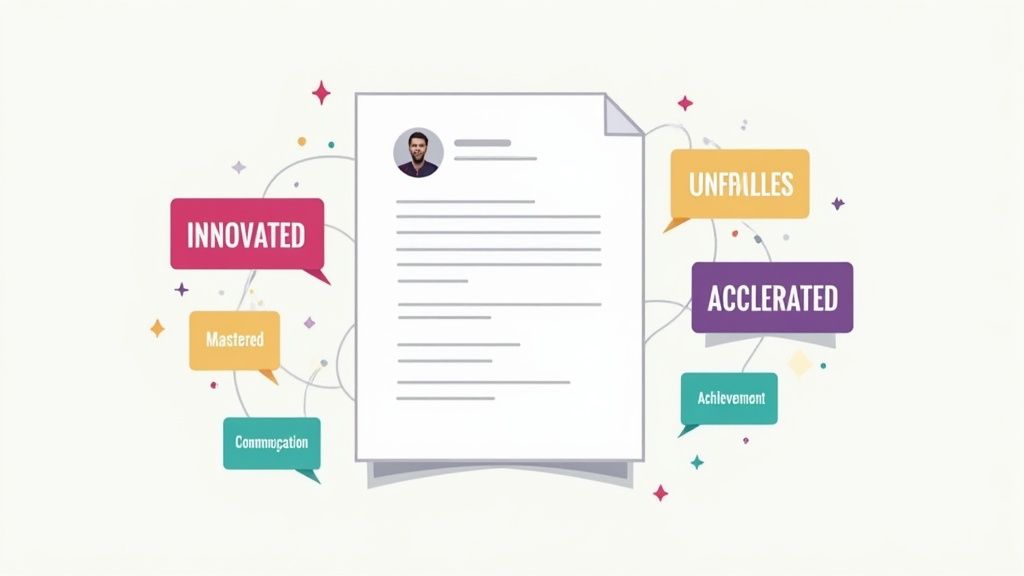
8 of the Best Resume Verbs to Land Interviews in 2025
In the high-stakes, rapid-fire world of job applications, every single word on your resume is a strategic asset or a liability. Generic verbs like “managed,” “handled,” or “was responsible for” are linguistic dead weight. They merely state a function, failing to convey the actual impact you made. To capture a recruiter’s attention in the crucial first few seconds, you need language that is dynamic, specific, and results-oriented. The difference between describing a duty and demonstrating an achievement often comes down to a single word.
This guide is your arsenal. We are moving beyond the obvious to provide a curated list of the best resume verbs that resonate with both Applicant Tracking Systems (ATS) and human hiring managers. You won’t just get a list; you’ll learn precisely how to pair these powerful words with quantifiable metrics to transform your experience section from a passive job description into a compelling narrative of your professional value.
We’ll dissect words like Orchestrated, Accelerated, and Pioneered, providing clear, actionable examples for each. By the end, you’ll understand how to strategically select verbs that not only describe your skills but also prove your ability to deliver tangible results, significantly boosting your chances of securing an interview.
1. Achieved
The word “Achieved” is one of the most powerful and effective resume verbs you can use. It immediately signals to a hiring manager that you are a results-oriented professional who not only completes tasks but also delivers tangible, successful outcomes. Unlike more passive verbs, “achieved” implies the overcoming of a challenge and the successful attainment of a specific goal.
Using this verb shifts the focus of your resume from simply listing job duties to showcasing your concrete contributions. It forces you to think in terms of measurable success, which is exactly what recruiters and hiring managers want to see. This makes it an essential component of any high-impact resume, especially when detailing your most significant accomplishments.

How to Use “Achieved” Effectively
The key to leveraging “achieved” is to pair it with specific, quantifiable data. Without metrics, the word loses its power. Always follow it with the numbers that prove your success. This approach transforms a vague statement into a compelling testament to your capabilities.
Examples of Implementation:
-
Weak: Responsible for sales.
-
Strong: Achieved 150% of annual sales quota for three consecutive years, generating over $2.3M in new business revenue.
-
Weak: Improved customer service.
-
Strong: Achieved a 98% customer satisfaction rating, a 15% increase from the previous year, by implementing new service protocols.
-
Weak: Handled procurement processes.
-
Strong: Achieved a 25% cost reduction in operational spending by renegotiating vendor contracts and implementing new procurement processes.
Actionable Tips for Maximum Impact
To ensure this verb works for you, follow these strategic guidelines:
- Quantify Everything: Always back up “achieved” with hard numbers. Use percentages, dollar amounts, timeframes, or other specific data points to provide context and scale.
- Connect to Business Goals: Frame your achievements in a way that highlights their impact on the company’s bottom line, such as increasing revenue, reducing costs, or improving efficiency.
- Be Specific: Instead of saying you “achieved success,” detail what you achieved. Was it a sales target, a project deadline, or a quality metric?
By incorporating “achieved” with solid evidence, you create a powerful narrative of professional success. For more strategies on framing your accomplishments, explore our guide on the best resume writing tips.
2. Spearheaded
The verb “Spearheaded” is a dynamic and compelling choice for any resume, signaling strong initiative and leadership. It conveys that you were not just a participant but the primary driving force behind a project, initiative, or significant change. Using “spearheaded” immediately positions you as a proactive leader who takes ownership and guides projects from conception to completion.
This powerful action verb suggests innovation and forward momentum. It tells a hiring manager that you are capable of identifying needs, formulating a plan, and leading a team toward a strategic objective. It’s an ideal word for demonstrating that you were the catalyst for progress, making it one of the best resume verbs for showcasing leadership potential.

How to Use “Spearheaded” Effectively
To maximize the impact of “spearheaded,” you must connect it to a specific initiative and its outcome. The verb implies a beginning, so it’s crucial to show the result of what you started. Quantifiable results are essential to prove the success of your leadership.
Examples of Implementation:
-
Weak: Led a digital project.
-
Strong: Spearheaded a digital transformation initiative that increased operational efficiency by 40% within 18 months.
-
Weak: Worked on the new product launch.
-
Strong: Spearheaded a cross-functional team of 12 to launch a new product line, resulting in $5M in first-year revenue.
-
Weak: Was in charge of a sustainability program.
-
Strong: Spearheaded the company-wide sustainability program, reducing the corporate carbon footprint by 30% and saving $200K in energy costs.
Actionable Tips for Maximum Impact
Follow these guidelines to make sure “spearheaded” powerfully communicates your leadership abilities:
- Highlight Initiative: Use this verb for projects you personally initiated or for which you had primary strategic ownership from the start.
- Emphasize Strategy: Frame the accomplishment to show the strategic nature of the project. Explain how your initiative aligned with broader company goals.
- Showcase Innovation: “Spearheaded” is perfect for describing change management or the introduction of new systems, processes, or products that had a transformative effect.
By pairing “spearheaded” with clear, impactful results, you effectively demonstrate your capacity to lead and deliver significant value.
3. Optimized
The verb “Optimized” is a strategic choice for professionals in analytical, technical, or operational roles. It immediately communicates an ability to enhance existing processes, systems, or performance through data-driven decisions and systematic improvements. Using “optimized” shows hiring managers you don’t just maintain the status quo; you actively seek out and implement efficiencies.
This powerful action word signals a mindset of continuous improvement and analytical thinking. It demonstrates that you can identify weaknesses, analyze data, and create solutions that lead to measurable gains in performance, cost savings, or productivity. This makes it one of the best resume verbs for showcasing your strategic value to a potential employer.

How to Use “Optimized” Effectively
To make “optimized” compelling, you must show the “before and after” picture with clear metrics. The verb is most powerful when it introduces a specific, quantifiable improvement. Vague claims of optimization will fall flat, so always support your statement with concrete data.
Examples of Implementation:
-
Weak: Worked on database queries.
-
Strong: Optimized database queries through index restructuring, reducing system response time by 60%.
-
Weak: Responsible for the supply chain.
-
Strong: Optimized supply chain logistics by implementing a new routing algorithm, cutting average delivery times from 5 to 3 days.
-
Weak: Ran marketing campaigns.
-
Strong: Optimized digital marketing campaigns using A/B testing, improving the lead conversion rate from 2% to 5.2%.
Actionable Tips for Maximum Impact
Follow these guidelines to ensure “optimized” highlights your problem-solving skills effectively:
- Show Before/After Metrics: Always quantify the improvement. Use percentages, time saved, or costs reduced to demonstrate the tangible result of your optimization efforts.
- Specify Your Method: Briefly mention the approach you used. Did you use A/B testing, a new software, a specific algorithm, or a process re-engineering technique?
- Connect to Business Value: Clearly link your optimization to a core business objective like increased revenue, enhanced user experience, or reduced operational costs.
By using “optimized” with specific data, you frame yourself as a strategic thinker who drives tangible results. To see how these verbs fit into a modern resume, check out our guide on creating an ATS-optimized resume template.
4. Generated
The verb “Generated” is a powerhouse for showcasing your direct impact on a company’s growth and success. It moves beyond simply performing a task to highlighting the creation of tangible value, whether that’s revenue, leads, savings, or opportunities. This verb is particularly effective for roles in sales, marketing, and business development, as it immediately tells a hiring manager that you are a producer.
Using “Generated” on your resume proves you understand the connection between your daily activities and the company’s core objectives. It signals that you are not just busy, but productive, and that you actively contribute to the bottom line. This makes it one of the best resume verbs for anyone looking to demonstrate their ability to deliver measurable results.
How to Use “Generated” Effectively
The strength of “Generated” lies in its connection to specific, quantifiable outcomes. To make it compelling, you must pair it with the exact figures that illustrate the value you created. This transforms a simple job duty into a powerful statement of your contribution.
Examples of Implementation:
-
Weak: Worked on partnerships.
-
Strong: Generated $1.8M in new business revenue through the development of three strategic partnerships in the SaaS sector.
-
Weak: Ran content marketing campaigns.
-
Strong: Generated an average of 2,500 qualified marketing leads monthly through targeted content marketing and SEO initiatives.
-
Weak: Handled vendor contracts.
-
Strong: Generated cost savings of $500K annually by renegotiating key vendor contracts and optimizing supply chain logistics.
Actionable Tips for Maximum Impact
To ensure this verb grabs a recruiter’s attention, follow these strategic tips:
- Be Numeric: Always support “Generated” with specific numbers. Use dollar amounts, lead counts, percentages, or other hard data to quantify your impact.
- Specify the Method: Briefly mention the “how.” Did you generate leads through social media, or did you generate revenue through cold calling? Adding this context makes your claim more credible.
- Define the Timeframe: Contextualize your accomplishments by including a timeframe, such as “monthly,” “quarterly,” or “over six months,” to show consistency and scale.
By using “Generated” with concrete evidence, you clearly communicate your role as a value creator, making your resume stand out to any employer.
5. Transformed
The word “Transformed” is an incredibly dynamic resume verb that signifies profound and lasting change. It communicates to hiring managers that you are not just a manager or a participant but a catalyst for major, positive evolution. Using “transformed” suggests you can overhaul inefficient systems, revitalize underperforming teams, and drive substantial organizational growth.
This verb is best reserved for your most significant, game-changing accomplishments. It frames you as a strategic visionary capable of seeing a need for fundamental change and executing a plan to make it happen. Including “transformed” on your resume immediately elevates you from a candidate who maintains the status quo to one who creates a new, better one, making it a key part of the best resume verbs for high-impact roles.

How to Use “Transformed” Effectively
To make “transformed” truly compelling, you must provide a clear before-and-after picture supported by data. The verb’s power comes from showing the scale of the change you initiated. Quantify the starting point and the end result to demonstrate the tangible value of your work.
Examples of Implementation:
-
Weak: Worked with the sales team.
-
Strong: Transformed an underperforming sales team into the top-grossing regional division, increasing revenue by 200% within 18 months.
-
Weak: Updated the customer service department.
-
Strong: Transformed customer service operations by introducing a new CRM and training program, improving satisfaction scores from 60% to 95%.
-
Weak: Was in charge of IT infrastructure.
-
Strong: Transformed the company’s outdated IT infrastructure to a cloud-based system, reducing system downtime by 85% and saving $200K annually.
Actionable Tips for Maximum Impact
Follow these guidelines to ensure this powerful verb adds significant weight to your resume:
- Show Before-and-After: Clearly state the initial problem or metric and the improved state after your intervention. This contrast is what makes the transformation impressive.
- Specify Scope and Scale: Mention what you transformed. Was it a process, a department, a company culture, or a technological system? Be specific about the scope of your influence.
- Highlight Long-Term Impact: Explain how your transformation delivered sustained value, such as ongoing cost savings, increased market share, or enhanced operational efficiency.
By using “transformed” with clear, quantifiable evidence, you position yourself as a powerful agent of change and a highly valuable asset to any organization.
6. Orchestrated
The word “Orchestrated” is a sophisticated and powerful resume verb that signals high-level coordination and strategic management. It suggests you are not just a manager but a visionary who can harmoniously align multiple complex parts, people, and processes to achieve a singular, successful outcome. Using “orchestrated” positions you as someone who can handle significant complexity with finesse and control.
This verb elevates your accomplishments beyond simple project management. It implies a mastery over chaos, making it an excellent choice for roles in leadership, event planning, large-scale project management, or any position requiring the skillful integration of diverse components. It tells a recruiter you can see the big picture while expertly managing the intricate details.
How to Use “Orchestrated” Effectively
To make “orchestrated” impactful, you must demonstrate the scale and complexity of what you managed. The key is to detail the different moving parts you brought together and the successful result of your coordination. This verb is most effective when describing multi-faceted initiatives.
Examples of Implementation:
-
Weak: Managed a company merger.
-
Strong: Orchestrated a seamless company merger involving 500+ employees across three international locations, ensuring 100% operational continuity.
-
Weak: Ran a marketing campaign.
-
Strong: Orchestrated a multi-channel product launch campaign across eight marketing channels, reaching over two million prospective customers and exceeding lead generation goals by 40%.
-
Weak: Created a disaster recovery plan.
-
Strong: Orchestrated the company-wide implementation of a new disaster recovery protocol, minimizing potential business disruption to under four hours.
Actionable Tips for Maximum Impact
To ensure this verb highlights your strategic abilities, follow these guidelines:
- Detail the Complexity: Use this verb for complex, multi-stakeholder projects. Clearly state the number of people, departments, vendors, or channels involved to showcase the coordination challenge.
- Specify the Components: Break down what you coordinated. Did you align technology, logistics, personnel, and communications? Mentioning the different elements adds weight.
- Emphasize the Unified Outcome: Conclude by stating the successful, unified result of your efforts. How did your orchestration benefit the organization?
By using “orchestrated” correctly, you communicate your ability to manage complex scenarios with strategic oversight, making you a top-tier candidate. For more ideas on showcasing your management skills, see our article on how to write a resume for a management position.
7. Pioneered
“Pioneered” is a high-impact verb that signals you are an innovator, a leader, and a forward-thinker. It immediately tells hiring managers that you don’t just follow trends; you create them. This verb is perfect for showcasing your ability to introduce new ideas, processes, or technologies that have had a lasting, positive impact.
Using “pioneered” positions you as a trailblazer who is not afraid to venture into uncharted territory to drive progress. It moves beyond simple task completion to highlight your role as a catalyst for significant change, making it one of the best resume verbs for roles that demand creativity, initiative, and strategic vision.
How to Use “Pioneered” Effectively
The power of “pioneered” comes from demonstrating a clear “before and after” scenario. You must connect your innovative action to a tangible business outcome or a widespread adoption that proves its success. Without this context, the claim can seem unsubstantiated.
Examples of Implementation:
-
Weak: Created a remote work policy.
-
Strong: Pioneered a flexible remote work policy that became the company-wide standard, boosting employee retention by 20% and later adopted by 20+ organizations in our industry.
-
Weak: Worked on customer service AI.
-
Strong: Pioneered the company’s first AI-powered customer service solution, successfully reducing average ticket response time by 70% within six months.
-
Weak: Thought of a new packaging idea.
-
Strong: Pioneered a sustainable packaging initiative using biodegradable materials, resulting in an annual cost savings of over $300K and a 15% reduction in carbon footprint.
Actionable Tips for Maximum Impact
To make sure this verb delivers the intended punch, follow these guidelines:
- Verify Your “First”: Ensure you were genuinely the first or a very early adopter of the concept within your company or team to use the verb accurately.
- Show the Impact: Clearly connect your innovation to positive business results like cost savings, revenue growth, improved efficiency, or enhanced customer satisfaction.
- Highlight Adoption: If your idea was replicated by other teams or became a new standard, mention it. This validates the success and importance of your initiative.
By using “pioneered” correctly, you showcase yourself as a valuable and innovative asset. To better align such powerful verbs with specific job roles, learn more about how you can tailor your resume to the job description.
8. Accelerated
The word “Accelerated” is a dynamic and compelling verb that shows you don’t just complete tasks; you drive them forward with urgency and efficiency. It signals to a hiring manager that you are a catalyst for progress, capable of speeding up timelines, boosting growth, and delivering results ahead of schedule. Using “accelerated” positions you as a proactive and high-impact individual who understands the value of time in a business context.
This verb shifts the narrative from passive participation to active contribution. It tells recruiters that you have the skills to streamline processes, remove bottlenecks, and push projects across the finish line faster than expected. This makes “accelerated” one of the best resume verbs for demonstrating your ability to add immediate value and create momentum within an organization.
How to Use “Accelerated” Effectively
The power of “accelerated” is unlocked when you provide a clear before-and-after picture. You must quantify the speed improvement by comparing it to previous timelines, industry benchmarks, or project goals. This context is crucial for demonstrating the tangible impact of your efficiency.
Examples of Implementation:
-
Weak: Worked on product development.
-
Strong: Accelerated the product development lifecycle from 12 to 8 months by introducing agile methodologies, enabling an earlier market release.
-
Weak: Helped new team members get started.
-
Strong: Accelerated the team onboarding process by creating a new digital training module, reducing time-to-productivity by 40%.
-
Weak: Involved in market entry planning.
-
Strong: Accelerated the market entry timeline by six months through strategic partnership negotiations, capturing a critical first-mover advantage.
Actionable Tips for Maximum Impact
To make sure “accelerated” enhances your resume, apply these specific strategies:
- Quantify the Time Saved: Always specify the reduction in time, whether in months, weeks, or as a percentage. This provides a clear measure of your efficiency.
- Show the Business Impact: Connect the faster delivery to a positive business outcome. Did it lead to increased revenue, market share, or a competitive edge?
- Mention Quality: Briefly note that speed did not come at the expense of quality. Phrases like “while maintaining quality standards” or “without compromising accuracy” add significant credibility.
Top 8 Resume Verbs Comparison
| Action Verb | Implementation Complexity 🔄 | Resource Requirements ⚡ | Expected Outcomes 📊 | Ideal Use Cases 💡 | Key Advantages ⭐ |
|---|---|---|---|---|---|
| Achieved | Low - straightforward to demonstrate | Moderate - needs supporting data | Concrete goal completion and measurable success | Universal across all sectors | Quantifiable impact; results-driven; universally appealing |
| Spearheaded | High - requires leading initiatives | High - substantial involvement | Successful project launches and leadership impact | Leadership roles, strategic projects | Strong leadership connotation; shows initiative and ownership |
| Optimized | Medium - analytical and technical | Moderate - data and examples needed | Improved efficiency and performance | Tech, operations, marketing, finance | Demonstrates analytical thinking; measurable improvements |
| Generated | Low to medium - focuses on outputs | Moderate - specific metrics needed | Creation of value, revenue, or leads | Sales, marketing, business development, finance | Clear ROI; direct business impact; easily quantifiable |
| Transformed | High - major organizational change | High - significant scope required | Significant and lasting improvements | Leadership, consulting, organizational development | Demonstrates major change capability; strategic impact |
| Orchestrated | High - managing complex projects | High - requires coordination of many elements | Harmonious multi-stakeholder outcomes | Project management, event planning, marketing, operations | Sophisticated project management; cross-functional leadership |
| Pioneered | High - introducing innovations | High - evidence of first implementation | Industry-first or novel achievements | Innovation-driven roles, startups, tech leaders | Shows innovation leadership; trendsetting and risk-taking |
| Accelerated | Medium - speeding up processes | Moderate - needs comparison data | Faster delivery or growth beyond normal pace | Fast-paced industries like tech, consulting, startups | Demonstrates efficiency; exceeds expectations; urgent execution |
Put Your Words Into Action: The Next Step in Your Job Search
You now have a powerful arsenal of the best resume verbs at your disposal, from “Achieved” and “Spearheaded” to “Pioneered” and “Accelerated.” Integrating these words into your resume is more than just a simple vocabulary upgrade; it’s a fundamental shift in how you present your professional story. It’s the difference between saying you were part of a team and demonstrating that you orchestrated a project that delivered measurable results.
The true power of this approach lies in its ability to transform passive statements into compelling narratives of success. Each action verb acts as a trigger, prompting you to follow up with a concrete metric or a specific outcome. This is the formula that gets your resume past Applicant Tracking Systems (ATS) and captures the attention of a hiring manager who may only spend a few seconds on their initial review.
Your Action Plan for a High-Impact Resume
Moving from theory to practice is the most critical step. Don’t just read this list; actively apply it to your own experience. Here is a clear, actionable plan to get you started immediately:
- Conduct a Verb Audit: Print out your current resume and circle every single verb you’ve used in your experience section. Are they passive (e.g., “Responsible for,” “Tasked with”) or active? This visual check will quickly reveal areas for improvement.
- Target and Replace: Go through your resume, bullet point by bullet point. For each responsibility, ask yourself, “What was the action I took, and what was the result?” Replace weak verbs with stronger, more specific alternatives from the categories we’ve explored.
- Quantify Everything Possible: Once you’ve added a powerful verb like Optimized, your next thought should be, “By how much?” Adding a number, percentage, or dollar amount gives your claim credibility and impact. For example, change “Optimized workflow processes” to “Optimized workflow processes, reducing project completion time by 15%.”
Mastering the use of the best resume verbs is a career-long skill. It ensures your resume isn’t just a historical document but a dynamic marketing tool that clearly articulates the value you bring to a potential employer. By focusing on action and results, you position yourself as a proactive problem-solver and a high-value candidate. This meticulous effort is an investment that pays dividends, turning your resume from a simple list of duties into a powerful argument for why you deserve an interview. Take these insights, refine your document, and get ready to turn applications into opportunities.
Ready to put this advice into practice effortlessly? Stop guessing which verbs will make the biggest impact. Let Jobcamp’s AI-powered platform scan your resume and instantly suggest the most effective action words tailored to your target job description. Build a winning resume in minutes with Jobcamp and ensure every application you send is optimized for success.

